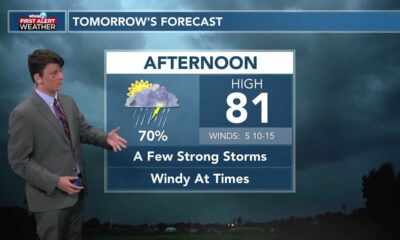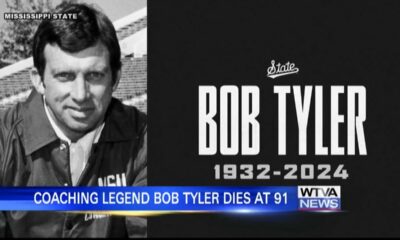Kaiser Health News
Doctors Abandon a Diagnosis Used to Justify Police Custody Deaths. It Might Live On, Anyway.
Markian Hawryluk and Renuka Rayasam
Mon, 16 Oct 2023 09:00:00 +0000
Brooks Walsh hadn't questioned whether “excited delirium syndrome” was a legitimate medical diagnosis before the high-profile police killings of Elijah McClain in Colorado in 2019 and George Floyd in Minnesota in 2020.
The emergency physician in Bridgeport, Connecticut, was familiar with the term from treating patients who were so severely agitated and combative that they needed medication just to be evaluated.
But it gave him pause when excited delirium — and not the restraint tactics used by arresting police officers — was mentioned as a possible factor in the deaths of those two Black men. That's when Walsh took a closer look at the American College of Emergency Physicians' 2009 position paper on excited delirium, which he and other physicians had relied on to treat such patients, then decided something needed to be done.
“I was disappointed by a lot of stuff in that paper: the quality of the evidence that they cite and just, frankly, odd language,” Walsh said.
Excited delirium is not listed in the standard reference book of mental health conditions, nor does it have its own diagnostic code under a system used by health professionals to identify diseases and disorders. No blood test or other diagnostic test can confirm the syndrome. Most major medical societies, including the American Medical Association and the American Psychiatric Association, no longer recognize excited delirium as a legitimate medical condition. One of the last medical holdouts, the National Association of Medical Examiners, rejected excited delirium as a cause of death this year.
But the American College of Emergency Physicians, the medical society representing Walsh and more than 36,000 other doctors, still hadn't disavowed its report that gave excited delirium much of its legitimacy — until this month. On Oct. 12, the group approved a resolution that Walsh co-authored to withdraw the 2009 white paper on excited delirium, removing the only remaining official medical pillar of support for a theory, which despite being based primarily on discredited research and racial biases, has played a key role in absolving police of culpability for in-custody deaths.
“This is the membership of ACEP saying we recognize that this was wrong,” said Sophia Spadafore, an emergency physician at Mount Sinai Hospital in New York City. “And now, as an organization, we need to reckon with our history and try to make up for some of the mistakes that were made and repair some of the damage that we did.”
The vote brought some vindication to Verdell and William Haleck, whose son Sheldon died in 2015 after being pepper-sprayed, shocked with a Taser, and restrained. The Utah family lost its civil case against Honolulu police officers, whose lawyers argued the 38-year-old former Hawaii Air National Guardsman had experienced excited delirium. Watching defense experts paint their son as responsible for his own death was excruciating, his parents said.
“We were right all along,” Verdell Haleck said in response to the ACEP vote. “Now our hopes are that the term can never be used again to cause pain and suffering for another family in their pursuit of justice.”
And momentum is building. Just before the vote, California became the first state to ban excited delirium as a diagnosis and cause of death on death certificates, autopsy reports, and police reports, as well as in civil court proceedings.
Backers of the emergency physicians' resolution hope such disavowals of the term will lead to better training and greater accountability of paramedics and police when they interact with people in mental health crises.
But it is unlikely the doctors' vote can affect past wrongful death and criminal cases against police. And it remains unclear whether renouncing the 2009 document will prevent defense lawyers in future cases from using similar victim-blaming concepts — just with alternative terminology.
‘This Drastically Affected Our Lives'
Nearly 14 years ago, Patrick Burns, 50, died after sheriff's deputies hogtied him and shocked him multiple times with Tasers in Sangamon County, Illinois, according to court documents. A medical examiner concluded the official cause of death was excited delirium.
That diagnosis in Burns' death stymied the family's lawsuit against the county officers, which ended in a $40,000 settlement in 2015, said Richard Burns, one of Patrick's brothers. The label also helped law enforcement create a picture of him as someone who was “out of control,” which ruined his brother's reputation, Richard said. “That picture is implanted on who my brother was, and that's not the truth.”
The term “excited delirium” dates back decades but has never been supported by rigorous scientific studies. Still, the term persisted as some of its early researchers earned money for testifying as expert witnesses in cases involving law enforcement and the company now called Axon Enterprises, which makes the Taser stun gun.
The theory suggested that agitated, delirious individuals were dying not because they had been shocked by stun guns, restrained with chokeholds, or held facedown so they couldn't breathe, but because of this unexplained medical condition that could lead to sudden death.
Funding from Taser International, Axon's former company name, sponsored some of the research forming the basis of ACEP's white paper supporting the excited delirium theory, according to a 2017 Reuters investigation. The 19-person task force that drafted the 2009 paper included three people who provided paid testimony or performed consulting work for Taser, that report found. KFF Health News called eight of the task force members but none agreed to interviews. Axon executives did not respond to calls or emails seeking comment on the white paper.
That ACEP paper described patients with excessive delirium as having superhuman strength, being impervious to pain, exhibiting aggressive behavior, and making guttural sounds. To Walsh and other doctors behind the push to reject the diagnosis, those descriptions reflected age-old racist tropes of Black men as being stronger than white men or being animalistic. The incorrect notion that Black people feel less pain persists in modern medicine and has led to disparities in pain treatment.
Indeed, excited delirium has been cited more often in cases involving people of color. According to a Virginia Law Review article, at least 56% of police custody deaths from 2010 to 2020 attributed to excited delirium involved Black and Latino victims. Reviews of deaths attributed to excited delirium also found they overwhelmingly occurred when people were being restrained.
Yet the authority of the esteemed doctors group and its position paper helped cement an alternative cause of death that defense attorneys for police argued in court. And now, it's likely too late for families who lost cases based on an excited delirium defense. Even with ACEP's disavowal, courts may be reluctant to reopen resolved cases, said Jim Davy, a civil rights lawyer in Philadelphia.
In June, just months after the National Association of Medical Examiners decided excited delirium should no longer be listed as a cause of death, the county coroner changed Patrick Burns' official manner of death to homicide. The coroner concluded he had suffered brain damage due to a lack of oxygen after being restrained on his stomach, not from excited delirium.
But the Illinois state attorney declined to pursue new charges against the deputies in Burns' death.
“It's more than just an unfortunate story,” Richard Burns said. “This drastically affected our lives.”
Racial Reckoning Sparks Shift
At a 2020 American Medical Association policy conference, medical students spurred by the racial reckoning in the wake of the police-involved deaths of Floyd and many others introduced a series of resolutions around combating racism in medicine, including one against excited delirium. But emergency physicians, who also belong to that broader physician group, objected.
“They're regarded as the content experts on the issue, and so I think it was hard for us to combat some of those counterarguments at that time,” said Rohan Khazanchi, a medical resident and a researcher with the FXB Center for Health and Human Rights at Harvard University.
Emergency physicians see patients with agitation and delirium more often than clinicians in other specialties do and oversee emergency medical technicians and paramedics who encounter such individuals outside of a hospital.
The AMA decided to study the issue. Its subsequent report firmly sided with the medical students and, in 2021, the AMA delegates issued a strong condemnation of excited delirium as a clinical diagnosis.
But ACEP, which represents a predominantly white specialty, dragged its feet in addressing its problematic paper. Instead, the group released a new policy statement in 2021 using the term “hyperactive delirium,” saying the guidance was not meant as an update or refutation of the paper.
Jeffrey Goodloe, an emergency physician in Tulsa, Oklahoma, and one of the authors of the 2021 policy statement, said ACEP didn't want to issue a statement without providing a clinical document to help guide physicians. And since the task force wanted to focus on clinical considerations, he said, it avoided addressing “excited delirium,” which had been under fire.
“It was being used in nonclinical ways, which no one ever really thought that it would be,” he said. “It was becoming at times a flashpoint between law enforcement and the community at large.”
This spring, the group issued a statement saying it no longer recognized excited delirium as a diagnosis but stopped short of retracting the 2009 white paper. And until this month's vote, it hadn't taken any steps to prevent its name and policy statement from being used by defense attorneys defending police in court cases involving in-custody deaths.
Goodloe, who now chairs the ACEP board, said it was hard for ACEP to track individual court cases and what expert witnesses were saying, especially if they were not ACEP members.
“We can't ensure how nonmedical professionals use a document that is designed to inform and guide medical care,” he said. “I would hope that they would continue to recognize the primary intent of the paper and be very meticulous about avoiding misquoting or mischaracterizing what that paper is for.”
New Terms Arise
The remaining defenders of the term insist that excited delirium is a real condition that puts patients, physicians, and first responders at risk.
One of the 2009 white paper's co-authors, Deborah Mash, a retired professor of neurology at the University of Miami, declined an interview but wrote in an email that the task force that penned the white paper included some of the most respected thought leaders in emergency medicine at the time, who sought to suggest best practices for treating patients with such symptoms.
Since then, she said, “banning the use of the ‘term' has caught on with the anti-police movement.”
Mash has testified about excited delirium as an expert witness for the defense in wrongful death claims filed against Axon over the use of its Tasers.
Some lawyers who bring in-custody death cases on behalf of families believe the ACEP reversal will help wipe out a major police defense tactic.
“It has a huge impact on cases going forward, because the white paper was the main vehicle for trying to legitimize excited delirium,” said Julia Sherwin, a civil rights attorney who is representing the family of Mario Gonzalez, who died in police custody in California in 2021.
But eradicating the term “excited delirium” may not stop police from trying to use the theory behind it to justify the deaths of suspects in custody: The Minneapolis Star-Tribune reported last year that a training for the Minneapolis Police Department, which was involved in Floyd's death, used PowerPoint slides with the words “excited delirium” crossed out and replaced with the term “severe agitation with confusion (delirium).”
Clinical documents from ACEP and other organizations have described the same cluster of symptoms at various times as hyperactive delirium, agitated delirium, or restraint-related cardiac arrest. Defense lawyers might argue the same concept using those terms or rely on other medical conditions to explain a death rather than law enforcement officials' use of force.
“It's so easy for them, once the excited delirium argument is dismissed, to use another kind of medical argument that's quite similar,” said Justin Feldman, a social epidemiologist at Harvard University who studies patterns of in-custody deaths.
In April 2021, Gonzalez died after police officers in Alameda, California, restrained him on his stomach, handcuffed him, and placed their weight on him. The county coroner listed his death as a homicide. But ACEP member Gary Vilke, one of the co-authors of the 2009 white paper, said in a September 2023 deposition he believed that Gonzalez died of cardiac dysrhythmia, an irregular heartbeat.
Vilke testified in the deposition that he could make up to $50,000 as a defense expert in the case, which is set to go to trial later this year, and that he has testified in restraint or law enforcement-related cases 58 times over the past four years. Vilke declined to comment to KFF Health News on the white paper.
California's new law lists alternative terms — hyperactive delirium, agitated delirium, and exhaustive mania — that will be restricted along with excited delirium starting in January. Nothing in the law prevents defense experts from using other medical explanations, such as cardiac dysrhythmia, for the deaths.
“People in agitated states due to cocaine, methamphetamine or untreated psychiatric illness still require help which is provided by police and first responders,” Mash, who helped create the 2009 paper, wrote in an email. “These individuals are at increased risk of sudden death regardless of what you call it.”
Still, Richard Burns, the Halecks, and others whose loved ones died during police encounters hope the ACEP vote prevents future abuses, pushes more states to follow California's lead, and boosts police accountability.
“What needs to happen is to focus on the why, the reason, the cause,” said Burns. “The cause is the police brutality, which gets minimized when it's being able to be hidden behind these terms.”
Chris Vanderveen, KUSA-TV's director of special projects, contributed to this report.
——————————
By: Markian Hawryluk and Renuka Rayasam
Title: Doctors Abandon a Diagnosis Used to Justify Police Custody Deaths. It Might Live On, Anyway.
Sourced From: kffhealthnews.org/news/article/excited-delirium-diagnosis-police-custody-deaths-emergency-doctors-renounce/
Published Date: Mon, 16 Oct 2023 09:00:00 +0000
Did you miss our previous article…
https://www.biloxinewsevents.com/the-new-vaccines-and-you-americans-better-armed-than-ever-against-the-winter-blechs/
Kaiser Health News
Millions Were Booted From Medicaid. The Insurers That Run It Gained Medicaid Revenue Anyway.
Phil Galewitz, KFF Health News
Fri, 26 Apr 2024 13:55:00 +0000
Private Medicaid health plans lost millions of members in the past year as pandemic protections that prohibited states from dropping anyone from the government program expired.
But despite Medicaid's unwinding, as it's known, at least two of the five largest publicly traded companies selling plans have continued to increase revenue from the program, according to their latest earnings reports.
“It's a very interesting paradox,” said Andy Schneider, a research professor at Georgetown University's McCourt School of Public Policy, of plans' Medicaid revenue increasing despite enrollment drops.
Medicaid, the state-federal health program for low-income and disabled people, is administered by states. But most people enrolled in the program get their health care through insurers contracted by states, including UnitedHealthcare, Centene, and Molina.
The companies persuaded states to pay them more money per Medicaid enrollee under the assumption that younger and healthier people were dropping out — presumably for Obamacare coverage or employer-based health insurance, or because they didn't see the need to get coverage — leaving behind an older and sicker population to cover, their executives have told investors.
Several of the companies reported that states have made midyear and retrospective changes in their payments to plans to account for the worsening health status of members.
In an earnings call with analysts on April 25, Molina Healthcare CEO Joe Zubretsky said 19 states increased their payment rates this year to adjust for sicker Medicaid enrollees. “States have been very responsive,” Zubretsky said. “We couldn't be more pleased with the way our state customers have responded to having rates be commensurate with normal cost trends and trends that have been influenced by the acuity shift.”
Health plans have faced much uncertainty during the Medicaid unwinding, as states began reassessing enrollees' eligibility and dropping those deemed no longer qualified or who lost coverage because of procedural errors. Before the unwinding, plans said they expected the overall risk profile of their members to go up because those remaining in the program would be sicker.
UnitedHealthcare, Centene, and Molina had Medicaid revenue increases ranging from 3% to 18% in 2023, according to KFF. The two other large Medicaid insurers, Elevance and CVS Health, do not break out Medicaid-specific revenue.
The Medicaid enrollment of the five companies collectively declined by about 10% from the end of March 2023 through the end of December 2023, from 44.2 million people to 39.9 million, KFF data shows.
In the first quarter of 2024, UnitedHealth's Medicaid revenue rose to $20.5 billion, up from $18.8 billion in the same quarter of 2023.
Molina on April 24 reported nearly $7.5 billion in Medicaid revenue in the first quarter of 2024, up from $6.3 billion in the same quarter a year earlier.
On April 26, Centene reported that its Medicaid enrollment fell 18.5% to 13.3 million in the first quarter of 2024 compared with the same period a year ago. The company's Medicaid revenue dipped 3% to $22.2 billion.
Unlike UnitedHealthcare, whose Medicaid enrollment fell to 7.7 million in March 2024 from 8.4 million a year prior, Molina's Medicaid enrollment rose in the first quarter of 2024 to 5.1 million from 4.8 million in March 2023. Molina's enrollment jump last year was partly a result of its having bought a Medicaid plan in Wisconsin and gained a new Medicaid contract in Iowa, the company said in its earnings news release.
Molina added 1 million members because states were prohibited from terminating Medicaid coverage during the pandemic. The company has lost 550,000 of those people during the unwinding and expects to lose an additional 50,000 by June.
About 90% of Molina Medicaid members have gone through the redetermination process, Zubretsky said.
The corporate giants also offset the enrollment losses by getting more Medicaid money from states, which they use to pass on higher payments to certain facilities or providers, Schneider said. By holding the money temporarily, the companies can count these “directed payments” as revenue.
Medicaid health plans were big winners during the pandemic after the federal government prohibited states from dropping people from the program, leading to a surge in enrollment to about 93 million Americans.
States made efforts to limit health plans' profits by clawing back some payments above certain thresholds, said Elizabeth Hinton, an associate director at KFF.
But once the prohibition on dropping Medicaid enrollees was lifted last spring, the plans faced uncertainty. It was unclear how many people would lose coverage or when it would happen. Since the unwinding began, more than 20 million people have been dropped from the rolls.
Medicaid enrollees' health care costs were lower during the pandemic, and some states decided to exclude pandemic-era cost data as they considered how to set payment rates for 2024. That provided yet another win for the Medicaid health plans.
Most states are expected to complete their Medicaid unwinding processes this year.
——————————
By: Phil Galewitz, KFF Health News
Title: Millions Were Booted From Medicaid. The Insurers That Run It Gained Medicaid Revenue Anyway.
Sourced From: kffhealthnews.org/news/article/medicaid-unwinding-insurer-revenue/
Published Date: Fri, 26 Apr 2024 13:55:00 +0000
Did you miss our previous article…
https://www.biloxinewsevents.com/california-is-investing-500m-in-therapy-apps-for-youth-advocates-fear-it-wont-pay-off/
Kaiser Health News
California Is Investing $500M in Therapy Apps for Youth. Advocates Fear It Won’t Pay Off.
Molly Castle Work
Fri, 26 Apr 2024 09:00:00 +0000
With little pomp, California launched two apps at the start of the year offering free behavioral health services to youths to help them cope with everything from living with anxiety to body acceptance.
Through their phones, young people and some caregivers can meet BrightLife Kids and Soluna coaches, some who specialize in peer support or substance use disorders, for roughly 30-minute virtual counseling sessions that are best suited to those with more mild needs, typically those without a clinical diagnosis. The apps also feature self-directed activities, such as white noise sessions, guided breathing, and videos of ocean waves to help users relax.
“We believe they're going to have not just great impact, but wide impact across California, especially in places where maybe it's not so easy to find an in-person behavioral health visit or the kind of coaching and supports that parents and young people need,” said Gov. Gavin Newsom's health secretary, Mark Ghaly, during the Jan. 16 announcement.
The apps represent one of the Democratic governor's major forays into health technology and come with four-year contracts valued at $498 million. California is believed to be the first state to offer a mental health app with free coaching to all young residents, according to the Department of Health Care Services, which operates the program.
However, the rollout has been slow. So slow that one of the companies has missed a deadline to make its app available on Android phones. Only about 15,000 of the state's 12.6 million children and young adults have signed up for the apps, and school counselors say they've never heard of them.
Advocates for youth question the wisdom of investing taxpayer dollars in two private companies. Social workers are concerned the companies' coaches won't properly identify youths who need referrals for clinical care. And the spending is drawing lawmaker scrutiny amid a state deficit pegged at as much as $73 billion.
An App for That
Newsom's administration says the apps fill a need for young Californians and their families to access professional telehealth for free, in multiple languages, and outside of standard 9-to-5 hours. It's part of Newsom's sweeping $4.7 billion master plan for kids' mental health, which was introduced in 2022 to increase access to mental health and substance use support services. In addition to launching virtual tools such as the teletherapy apps, the initiative is working to expand workforce capacity, especially in underserved areas.
“The reality is that we are rarely 6 feet away from our devices,” said Sohil Sud, director of Newsom's Children and Youth Behavioral Health Initiative. “The question is how we can leverage technology as a resource for all California youth and families, not in place of, but in addition to, other behavioral health services that are being developed and expanded.”
The virtual platforms come amid rising depression and suicide rates among youth and a shortage of mental health providers. Nearly half of California youths from the ages of 12 to 17 report having recently struggled with mental health issues, with nearly a third experiencing serious psychological distress, according to a 2021 study by the UCLA Center for Health Policy Research. These rates are even higher for multiracial youths and those from low-income families.
But those supporting youth mental health at the local level question whether the apps will move the needle on climbing depression and suicide rates.
“It's fair to applaud the state of California for aggressively seeking new tools,” said Alex Briscoe of California Children's Trust, a statewide initiative that, along with more than 100 local partners, works to improve the social and emotional health of children. “We just don't see it as fundamental. And we don't believe the youth mental health crisis will be solved by technology projects built by a professional class who don't share the lived experience of marginalized communities.”
The apps, BrightLife Kids and Soluna, are operated by two companies: Brightline, a 5-year-old venture capital-backed startup; and Kooth, a London-based publicly traded company that has experience in the U.K. and has also signed on some schools in Kentucky and Pennsylvania and a health plan in Illinois. In the first five months of Kooth's Pennsylvania pilot, 6% of students who had access to the app signed up.
Brightline and Kooth represent a growing number of health tech firms seeking to profit in this space. They beat out dozens of other bidders including international consulting companies and other youth telehealth platforms that had already snapped up contracts in California.
Although the service is intended to be free with no insurance requirement, Brightline's app, BrightLife Kids, is folded into and only accessible through the company's main app, which asks for insurance information and directs users to paid licensed counseling options alongside the free coaching. After KFF Health News questioned why the free coaching was advertised below paid options, Brightline reordered the page so that, even if a child has high-acuity needs, free coaching shows up first.
The apps take an expansive view of behavioral health, making the tools available to all California youth under age 26 as well as caregivers of babies, toddlers, and children 12 and under. When KFF Health News asked to speak with an app user, Brightline connected a reporter with a mother whose 3-year-old daughter was learning to sleep on her own.
‘It's Like Crickets'
Despite being months into the launch and having millions in marketing funds, the companies don't have a definitive rollout timeline. Brightline said it hopes to have deployed teams across the state to present the tools in person by midyear. Kooth said developing a strategy to hit every school would be “the main focus for this calendar year.”
“It's a big state — 58 counties,” Bob McCullough of Kooth said. “It'll take us a while to get to all of them.”
Brightline's contract states that the company was required to launch downloadable apps for iOS and Android phones by January, but so far BrightLife Kids is available only on Apple phones. Brightline said it's aiming to launch the Android version over the summer.
“Nobody's really done anything like this at this magnitude, I think, in the U.S. before,” said Naomi Allen, a co-founder and the CEO of Brightline. “We're very much in the early innings. We're already learning a lot.”
The contracts, obtained by KFF Health News through a records request, show the companies operating the two apps could earn as much as $498 million through the contract term, which ends in June 2027, months after Newsom is set to leave office. And the state is spending hundreds of millions more on Newsom's virtual behavioral health strategy. The state said it aims to make the apps available long-term, depending on usage.
The state said 15,000 people signed up in the first three months. When KFF Health News asked how many of those users actively engaged with the app, it declined to say, noting that data would be released this summer.
KFF Health News reached out to nearly a dozen California mental health professionals and youths. None of them were aware of the apps.
“I'm not hearing anything,” said Loretta Whitson, executive director of the California Association of School Counselors. “It's like crickets.”
Whitson said she doesn't think the apps are on “anyone's” radar in schools, and she doesn't know of any schools that are actively advertising them. Brightline will be presenting its tool to the counselor association in May, but Whitson said the company didn't reach out to plan the meeting; she did.
Concern Over Referrals
Whitson isn't comfortable promoting the apps just yet. Although both companies said they have a clinical team on staff to assist, Whitson said she's concerned that the coaches, who aren't all licensed therapists, won't have the training to detect when users need more help and refer them to clinical care.
This sentiment was echoed by other school-based social workers, who also noted the apps' duplicative nature — in some counties, like Los Angeles, youths can access free virtual counseling sessions through Hazel Health, a for-profit company. Nonprofits, too, have entered this space. For example, Teen Line, a peer-to-peer hotline operated by Southern California-based Didi Hirsch Mental Health Services, is free nationwide.
While the state is also funneling money to the schools as part of Newsom's master plan, students and school-based mental health professionals voiced confusion at the large app investment when, in many school districts, few in-person counseling roles exist, and in some cases are dwindling.
Kelly Merchant, a student at College of the Desert in Palm Desert, noted that it can be hard to access in-person therapy at her school. She believes the community college, which has about 15,000 students, has only one full-time counselor and one part-time bilingual counselor. She and several students interviewed by KFF Health News said they appreciated having engaging content on their phone and the ability to speak to a coach, but all said they'd prefer in-person therapy.
“There are a lot of people who are seeking therapy, and people close to me that I know. But their insurances are taking forever, and they're on the waitlist,” Merchant said. “And, like, you're seeing all these people struggle.”
Fiscal conservatives question whether the money could be spent more effectively, like to bolster county efforts and existing youth behavioral health programs.
Republican state Sen. Roger Niello, vice chair of the Senate Budget and Fiscal Review Committee, noted that California is forecasted to face deficits for the next three years, and taxpayer watchdogs worry the apps might cost even more in the long run.
“What starts as a small financial commitment can become uncontrollable expenses down the road,” said Susan Shelley of the Howard Jarvis Taxpayers Association.
This article was produced by KFF Health News, which publishes California Healthline, an editorially independent service of the California Health Care Foundation.
——————————
By: Molly Castle Work
Title: California Is Investing $500M in Therapy Apps for Youth. Advocates Fear It Won't Pay Off.
Sourced From: kffhealthnews.org/news/article/california-youth-teletherapy-apps-rollout-slow/
Published Date: Fri, 26 Apr 2024 09:00:00 +0000
Kaiser Health News
KFF Health News’ ‘What the Health?’: Abortion — Again — At the Supreme Court
Wed, 24 Apr 2024 20:30:00 +0000
The Host
Julie Rovner
KFF Health News
Julie Rovner is chief Washington correspondent and host of KFF Health News' weekly health policy news podcast, “What the Health?” A noted expert on health policy issues, Julie is the author of the critically praised reference book “Health Care Politics and Policy A to Z,” now in its third edition.
Some justices suggested the Supreme Court had said its piece on abortion law when it overturned Roe v. Wade in 2022. This term, however, the court has agreed to review another abortion case. At issue is whether a federal law requiring emergency care in hospitals overrides Idaho's near-total abortion ban. A decision is expected by summer.
Meanwhile, the Centers for Medicare & Medicaid finalized the first-ever minimum staffing requirements for nursing homes participating in the programs. But the industry argues that there are not enough workers to hire to meet the standards.
This week's panelists are Julie Rovner of KFF Health News, Joanne Kenen of the Johns Hopkins University's nursing and public health schools and Politico Magazine, Tami Luhby of CNN, and Alice Miranda Ollstein of Politico.
Panelists
Joanne Kenen
Johns Hopkins University and Politico
Tami Luhby
CNN
Alice Miranda Ollstein
Politico
Among the takeaways from this week's episode:
- This week's Supreme Court hearing on emergency abortion care in Idaho was the first challenge to a state's abortion ban since the overturn of the constitutional right to an abortion. Unlike previous abortion cases, this one focused on the everyday impacts of bans on abortion care — cases in which pregnant patients experienced medical emergencies.
- Establishment medical groups and doctors themselves are getting more vocal and active as states set laws on abortion access. In a departure from earlier political moments, some major medical groups are campaigning on state ballot measures.
- Medicaid officials this week finalized new rules intended to more closely regulate managed-care plans that enroll Medicaid patients. The rules are intended to ensure, among other things, that patients have prompt access to needed primary care doctors and specialists.
- Also this week, the Federal Trade Commission voted to ban most “noncompete” clauses in employment contracts. Such language has become common in health care and prevents not just doctors but other health workers from changing jobs — often forcing those workers to move or commute to leave a position. Business interests are already suing to block the new rules, claiming they would be too expensive and risk the loss of proprietary information to competitors.
- The fallout from the cyberattack of Change Healthcare continues, as yet another group is demanding ransom from UnitedHealth Group, Change's owner. UnitedHealth said in a statement this week that the records of “a substantial portion of America” may be involved in the breach.
Plus for “extra credit” the panelists suggest health policy stories they read this week that they think you should read, too:
Julie Rovner: NBC News' “Women Are Less Likely To Die When Treated by Female Doctors, Study Suggests,” by Liz Szabo.
Alice Miranda Ollstein: States Newsroom's “Loss of Federal Protection in Idaho Spurs Pregnant Patients To Plan for Emergency Air Transport,” by Kelcie Moseley-Morris.
Tami Luhby: The Associated Press' “Mississippi Lawmakers Haggle Over Possible Medicaid Expansion as Their Legislative Session Nears End,” by Emily Wagster Pettus.
Joanne Kenen: States Newsroom's “Missouri Prison Agency To Pay $60K for Sunshine Law Violations Over Inmate Death Records,” by Rudi Keller.
Also mentioned on this week's podcast:
- American Economic Review's “Is There Too Little Antitrust Enforcement in the U.S. Hospital Sector?” by Zarek Brot-Goldberg, Zack Cooper, Stuart Craig, and Lev Klarnet.
- KFF Health News' “Medical Providers Still Grappling With UnitedHealth Cyberattack: ‘More Devastating Than Covid,” by Samantha Liss.
Credits
Francis Ying
Audio producer
Emmarie Huetteman
Editor
To hear all our podcasts, click here.
And subscribe to KFF Health News' “What the Health?” on Spotify, Apple Podcasts, Pocket Casts, or wherever you listen to podcasts.
——————————
Title: KFF Health News' ‘What the Health?': Abortion — Again — At the Supreme Court
Sourced From: kffhealthnews.org/news/podcast/what-the-health-344-abortion-supreme-court-april-25-2024/
Published Date: Wed, 24 Apr 2024 20:30:00 +0000
Did you miss our previous article…
https://www.biloxinewsevents.com/mandatory-reporting-laws-meant-to-protect-children-get-another-look/
-
Local News4 days ago
Sister of Mississippi man who died after police pulled him from car rejects lawsuit settlement
-
Mississippi Today4 days ago
At Lake High School in Scott County, the Un-Team will never be forgotten
-
Mississippi Today22 hours ago
On this day in 1951
-
Mississippi News2 days ago
One injured in Mississippi officer-involved shooting after chase
-
Mississippi News6 days ago
Cicadas expected to takeover north Mississippi counties soon
-
Mississippi News6 days ago
Viewers make allegations against Hatley teacher, school district releases statement – Home – WCBI TV
-
Mississippi News Video5 days ago
Vehicle struck and killed man lying in the road, Alcorn County sheriff says
-
Mississippi Today7 days ago
On this day in 1892
































